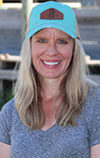"Economics should drive the decision [to creep feed or not]," says Matt Luebbe, a feedlot and nutrition specialist at the University of Nebraska – Lincoln. "If the return or the cost of gain is too much, it isn't worth it."
Luebbe recommends assessing your current feed sources in relation to creep feed. Likewise, Dan E. Eversole, a beef nutrition and management specialist at Virginia Tech, writes, "If high-quality pasture is inadequate or unavailable, supplemental creep feeding may be a viable alternative." Both Luebbe and Eversole encourage considering the cost in relation to the benefit.
"The decision to use creep feed is ranch specific and depends on management production," Luebbe says. Each producer must ask themselves if their feed supplies are limited to the point of capturing the value of the creep feed. If feed supplies are restricted or if you're trying to meet an April market with a spring-born calf, then creep feed may help finish the animal. "We must evaluate maximum and optimum," Luebbe says. Pushing for a calf's highest daily gain will put him at his maximum weight, but it may not be his optimal. "Producers must look at the cost of the extra feed inputs. If a calf is gaining an extra half-pound a day, is the cost of feed for that half-pound going to exceed the price point of the extra weight?"
Eversole states, "Generally speaking, the most efficient conversion of creep to added weaning weight exists when nursing calves are unable to attain normal weaning weights without supplemental feed. Best results from creep feeding generally occur when, one, forage is too mature for utilization by nursing calves; two, forage quantity is inadequate due to drought or overgrazing; or, three, calves are born to poor milking cows or first-calf heifers."
Creep feed needs to be high in protein for the calves because young animals are putting on muscle and frame, whereas older calves are adding fat for finishing. Creep feed that is high in protein and also palatable for the calves can add the weight needed.
Looking at a producer's long-term herd plan also helps make the decision. "It depends if the calves are going to a feedlot or if they're headed to winter pasture. If the calves are headed to a feedlot and the goal is pushing their gain, then creep feed may help you reach your goal if it's cost-effective. On the other hand, if you're holding the calves longer, then the cost of pushing the weight will likely exceed your production goals," Luebbe says.
Eversole adds that creep feeding replacement heifers may affect milk production. Fatty tissue can collect in the udder and decrease milk production. "When milk production and forage conditions are adequate for heifers to wean at acceptable weights, a good recommendation is to avoid creep feeding heifers that may be retained."
Eversole cautions that creep feeding is extremely difficult if calves are pastured with companion grazers such as sheep or goats. These animals will also access the creep feeder.
Calves will start nibbling feed at a couple weeks, but don't really consume measureable amounts until they are 6 to 8 weeks old. If creep feeding is chosen by a producer, calves will learn to feed by watching dams at bunks or from older calves. Feeders placed near water and shade will increase calf interest. Take care to watch for acidosis and consider intake inhibitors to regulate feed.
"Producers will set up good conditions for their cattle. They don't want them too fat or it affects rebreeding and isn't good for their health. Likewise, being too thin is problematic," Luebbe says. Finding the optimal weight for your herd and then using the resources available will produce good cattle and a favorable return. Luebbe encourages, "The decision is up to each producer based on their management practices. Use feed that will achieve good body condition and be cost-effective. Consider the price of feed in relation to current cattle market trends. Economics should drive the creep feeding decision." ![]()
Marci Whitehurst is a freelance writer based in Montana.
PHOTO: The decision to use creep feed is ranch specific and should be considered carefully. Photo by Marci Whitehurst.









